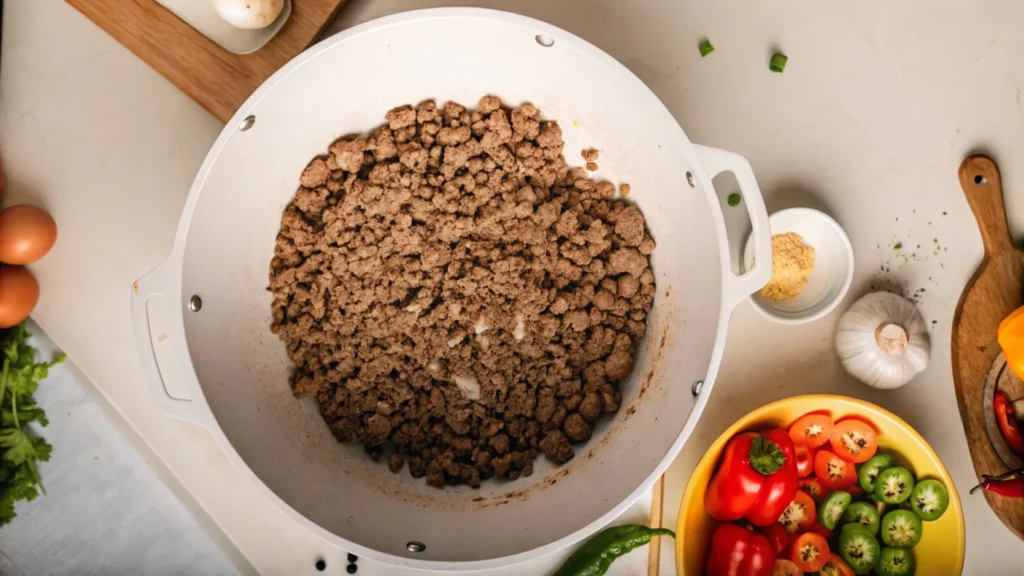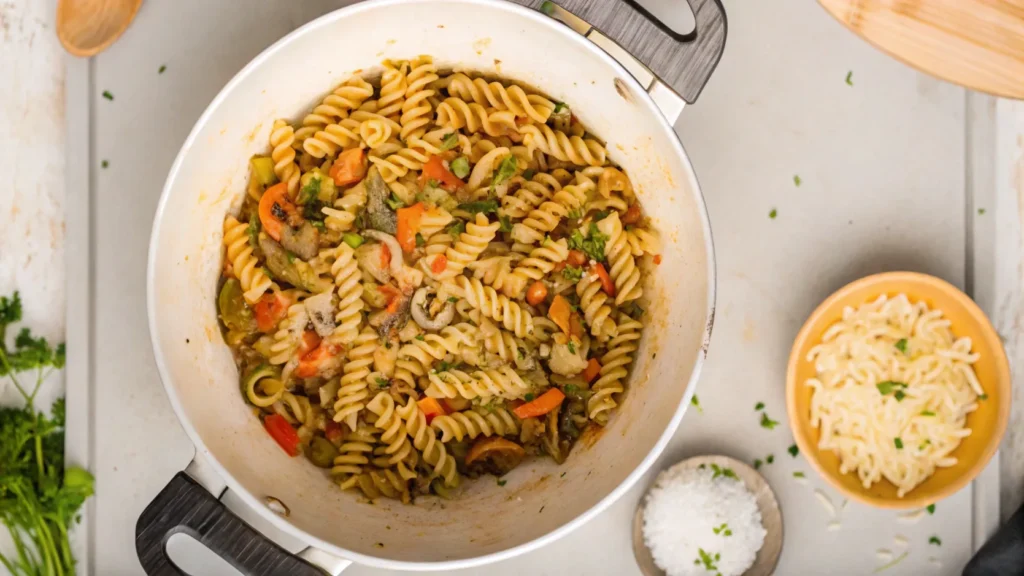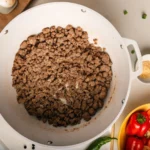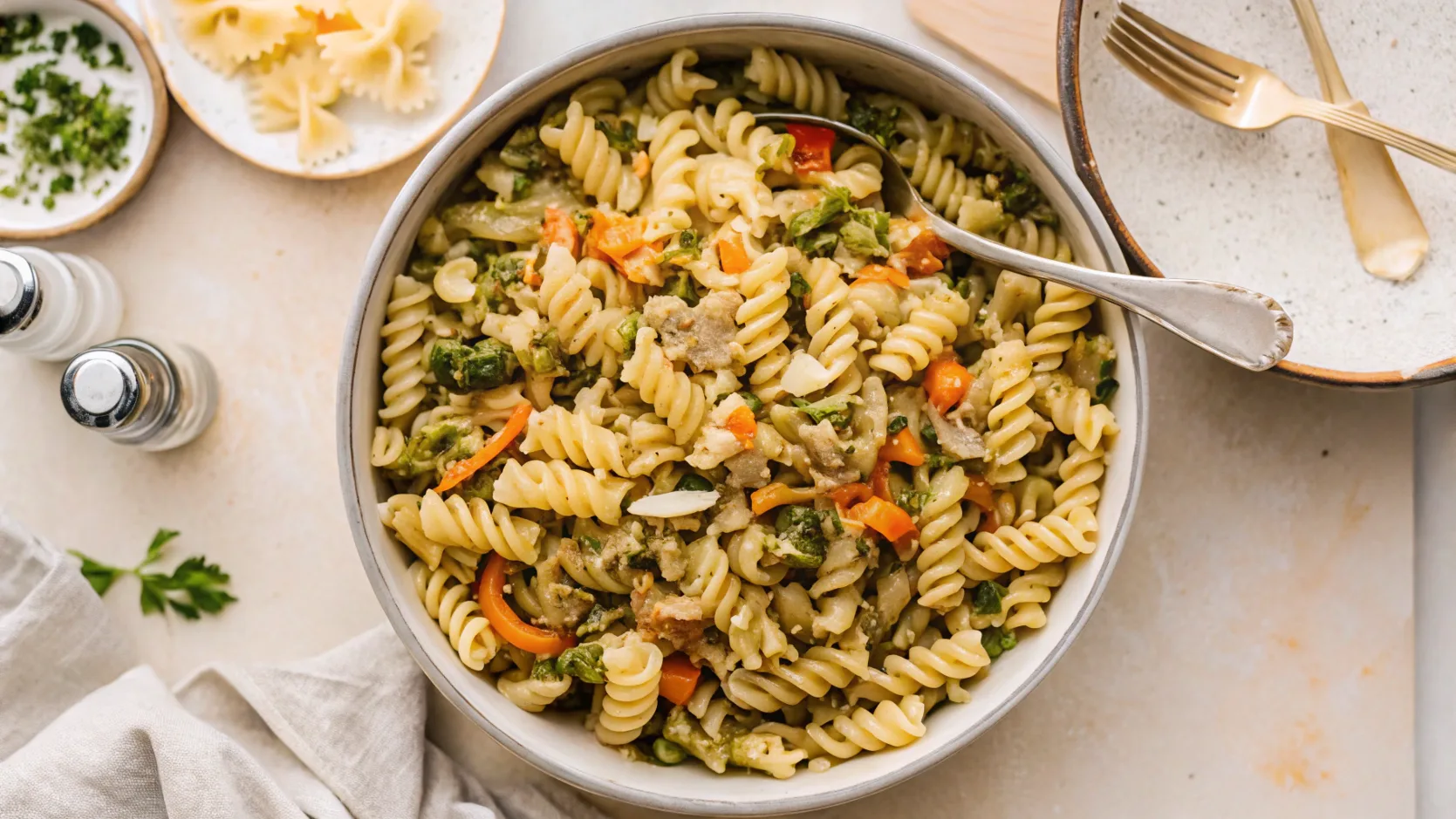When it comes to comfort food, few dishes hold the same charm as a Philly cheesesteak. That mouthwatering combination of tender steak, melted cheese, and caramelized onions is hard to resist. But what if you could take that classic sandwich and turn it into a pasta dish? Enter Philly Cheesesteak Pasta—a hearty, flavorful recipe that brings all the goodness of a Philly cheesesteak into a creamy, cheesy pasta form. Whether you’re craving a quick dinner or something to wow guests at your next gathering, this recipe is guaranteed to deliver on taste, texture, and satisfaction.
In this article, we’ll dive into everything you need to know about making Philly Cheesesteak Pasta at home. From the essential ingredients to helpful tips, we’ll guide you through the process of creating a dish that’s as indulgent as it is easy to prepare.
Table of Contents
What is Philly Cheesesteak Pasta?
Philly Cheesesteak Pasta is a delicious fusion dish that takes all the familiar flavors of a Philly cheesesteak sandwich and incorporates them into a comforting pasta dish. Think of it as the perfect combination of pasta and a cheesesteak: sautéed beef, bell peppers, onions, and a creamy, cheesy sauce that clings to every noodle. The result is a mouthwatering meal that’s as satisfying as it is easy to make.
The beauty of this dish lies in its versatility. It offers the same hearty and satisfying flavors as a traditional Philly cheesesteak but in a more approachable form. The creamy sauce perfectly complements the savory steak and vegetables, creating a dish that will satisfy your craving for something indulgent without being overly complicated.

What Ingredients Do You Need for Philly Cheesesteak Pasta?
Creating a dish as comforting as Philly Cheesesteak Pasta starts with gathering the right ingredients. Fortunately, this recipe doesn’t require anything too exotic. Below is a breakdown of the core ingredients you’ll need to get started:
Ingredient List:
| Ingredient | Amount | Notes |
|---|---|---|
| Ribeye Steak | 1 lb | Thinly sliced or shaved steak works best |
| Bell Peppers | 2 medium | Any color; red, green, or yellow work well |
| Onion | 1 medium | Sliced thin for better texture |
| Garlic | 3 cloves | Minced for a rich flavor |
| Cream Cheese | 4 oz | Adds creaminess to the sauce |
| Mozzarella Cheese | 1 cup | Shredded, provides a nice melt |
| Provolone Cheese | 1 cup | Shredded, gives that classic cheesesteak flavor |
| Pasta (penne or fettuccine) | 8 oz | Pick a pasta that holds sauce well |
| Salt & Pepper | To taste | For seasoning |
| Italian Seasoning | 1 tsp | Optional, for an extra flavor boost |
Instructions:
- Cook the pasta: Begin by cooking your pasta according to the package instructions. Be sure to reserve a cup of pasta water to add later to adjust the consistency of the sauce.
- Sauté the vegetables: While the pasta cooks, heat a large pan over medium heat. Add some olive oil and sauté the sliced onions and bell peppers until they are tender and lightly caramelized (about 5 minutes).
- Cook the steak: Next, add the thinly sliced steak to the pan. Cook for about 4-5 minutes until the steak is browned and cooked through. Be sure to season with salt, pepper, and a bit of Italian seasoning for added flavor.
- Make the cheesy sauce: In a separate pan, melt the cream cheese, then add the shredded mozzarella and provolone cheeses. Stir frequently until everything is melted into a smooth, creamy sauce. You can adjust the consistency with some of the reserved pasta water if necessary.
- Combine everything: Add the cooked pasta to the pan with the steak and veggies. Pour the creamy cheese sauce over the top and toss everything together to coat the pasta evenly.
- Serve: Garnish with extra cheese or chopped parsley if desired. Serve immediately, and enjoy your delicious Philly Cheesesteak Pasta!
What Are Some Variations of Philly Cheesesteak Pasta?
While the classic Philly Cheesesteak Pasta recipe is absolutely delicious, there are several ways you can tweak it to suit your preferences or dietary needs. Here are some variations to consider:
1. Make It Lighter with Chicken:
If you’re not a fan of beef or prefer a lighter option, you can easily substitute the ribeye steak with thinly sliced chicken breast or chicken thighs. Chicken adds a leaner protein while still providing that tender, juicy bite. The flavors of the veggies and cheese sauce will complement the chicken perfectly.
2. Add Extra Veggies:
If you want to boost the nutritional value of this dish, consider adding extra veggies. Mushrooms, spinach, or zucchini can easily be incorporated into the mix. These vegetables not only add flavor but also create a more well-rounded dish. You can sauté them along with the onions and peppers for added depth.
3. Spice It Up:
If you like a bit of heat, consider adding sliced jalapeños or a pinch of red pepper flakes to the mix. The mild heat will provide an exciting contrast to the creamy cheese sauce. Adjust the level of spiciness to your liking, making this a customizable option for spice lovers.
4. Gluten-Free Option:
For a gluten-free version of this dish, simply substitute the pasta with gluten-free penne or fettuccine. The rest of the ingredients in the recipe remain the same, so you can enjoy all the flavors of the dish without worrying about gluten.
5. Add a Crunchy Topping:
If you like a little texture in your pasta dishes, try topping your Philly Cheesesteak Pasta with some crunchy breadcrumbs or crispy onions. These toppings add a fun contrast to the creamy, cheesy sauce and provide an extra layer of flavor.

How to Prepare Philly Cheesesteak Pasta: Step-by-Step Instructions
Now that you have the ingredients and a few variations in mind, it’s time to walk through the step-by-step process of preparing this Philly Cheesesteak Pasta.
Step 1: Cook the Pasta
Begin by bringing a large pot of salted water to a boil. Add your pasta and cook until al dente. Be sure to reserve about one cup of pasta water before draining the pasta, as this will help to loosen up the sauce if needed.
Step 2: Sauté the Vegetables
While your pasta cooks, heat a large pan over medium heat. Add a tablespoon of olive oil and toss in the sliced onions and bell peppers. Stir occasionally, allowing the veggies to soften and caramelize for about 5 minutes.
Step 3: Cook the Steak
Once the vegetables are softened, add the thinly sliced steak to the pan. Cook for another 4-5 minutes until the steak is browned and cooked through. Season with salt, pepper, and Italian seasoning to enhance the flavor.
Step 4: Make the Cheese Sauce
In a separate pan, melt the cream cheese over medium heat. Once melted, gradually stir in the shredded mozzarella and provolone cheese. Keep stirring until the sauce is smooth and creamy. If the sauce is too thick, add a bit of the reserved pasta water to adjust the consistency.
Step 5: Combine Everything
Once your pasta is cooked and the cheese sauce is ready, add the pasta to the pan with the steak and veggies. Pour the cheese sauce over everything and toss until the pasta is evenly coated.
Step 6: Serve
Garnish with extra cheese or chopped parsley for a finishing touch. Serve immediately and enjoy!
What Are Common Mistakes to Avoid When Making Philly Cheesesteak Pasta?
While Philly Cheesesteak Pasta is relatively easy to make, there are a few common mistakes that could affect the flavor and texture of your dish. Here are some things to keep in mind to ensure that your pasta turns out perfectly every time:
1. Overcooking the Steak
The most important tip when making Philly Cheesesteak Pasta is to avoid overcooking the steak. Overcooked steak can turn tough and dry, which detracts from the dish’s overall texture. Make sure to slice the steak thinly and cook it just until it’s browned. Thin cuts like ribeye or sirloin work best because they stay tender when cooked quickly. Aim for a medium to medium-rare cook on the steak for the best result.
2. Not Seasoning Enough
Philly Cheesesteak Pasta relies on flavorful beef, peppers, onions, and a creamy cheese sauce. If you don’t season each layer properly, the dish can end up tasting bland. Be sure to season the steak with enough salt and pepper while cooking, and don’t forget to add some Italian seasoning or garlic powder to bring out the flavors in the vegetables. Additionally, adding some of the reserved pasta water to the sauce helps to blend all the ingredients together, enhancing the overall flavor.
3. Skipping the Pasta Water
When preparing the sauce, be sure to reserve some pasta water before draining the noodles. This starchy water can be added to the cheese sauce to create a smoother consistency. It also helps the sauce adhere to the pasta better, making it richer and creamier. Without it, your sauce might be too thick or not coat the pasta evenly. So don’t forget to save that pasta water!
4. Using Low-Quality Cheese
The cheese is a key component of Philly Cheesesteak Pasta, and using low-quality cheese can result in a bland or greasy sauce. Aim for full-fat cream cheese, and use a mix of mozzarella and provolone for that classic cheesesteak flavor. Don’t be tempted to use pre-shredded cheese, as it contains anti-caking agents that prevent it from melting smoothly. Freshly shredded cheese melts much better and creates a velvety sauce.
5. Using the Wrong Pasta
Choosing the right pasta can significantly impact your dish. While any pasta can technically work, opt for shapes like penne, fettuccine, or rigatoni, which can hold up to the heavy sauce. Lighter pasta types like spaghetti may not provide enough surface area to cling to the sauce. Penne is especially good because its hollow shape helps trap the cheese sauce inside, creating the perfect bite every time.
What to Serve with Philly Cheesesteak Pasta
- Creamy Garlic Parmesan Chicken Pasta – A rich and flavorful pasta dish perfect for a comforting meal.
- Garlic Parmesan Chicken Pasta – A rich and creamy pasta dish perfect for pairing.
Frequently Asked Questions (FAQs)
What is the secret ingredient in Philly cheesesteak?
The secret ingredient in a Philly cheesesteak is often the combination of melted cheese and perfectly seasoned steak. It’s all about balancing the flavors. In a Philly Cheesesteak Pasta, we keep it dairy-light with a smooth, creamy cheese sauce and tender ribeye steak. It adds richness without overwhelming the other flavors. Trust me, it’s the key to making this dish irresistible!
What sauces go on a Philly cheesesteak?
Philly cheesesteaks traditionally feature cheese whiz, provolone, or American cheese. However, the star in Philly Cheesesteak Pasta is the creamy cheese sauce. We use a dairy-light base, like Nutpods or any non-dairy milk, to keep it smooth and rich. In addition, you can add a sprinkle of garlic powder, paprika, and black pepper for an extra kick. It’s all about making it just right!
What is traditionally served with Philly cheesesteak?
Philly cheesesteaks are often served with crispy fries or a side salad to balance the richness. For Philly Cheesesteak Pasta, you can pair it with a light side, like a fresh green salad or roasted veggies. I love serving it with a slice of gluten-free garlic bread to soak up that creamy cheese sauce. It’s the perfect combo to enjoy with every bite!
What’s the difference between French dip and Philly cheesesteak?
The main difference between French dip and Philly cheesesteak is in the meat and preparation. A French dip uses thin-sliced roast beef served with a dipping sauce, while Philly cheesesteak is made with sautéed ribeye steak and melted cheese, usually served on a hoagie roll. In Philly Cheesesteak Pasta, we swap out the bread for pasta to create a creamy, indulgent version of this classic.
Conclusion: Why Philly Cheesesteak Pasta is the Perfect Comfort Food
In conclusion, Philly Cheesesteak Pasta combines the best of both worlds—hearty pasta and a classic Philly cheesesteak. It’s a delicious, comforting dish that brings the savory goodness of a cheesesteak sandwich into a creamy, cheesy pasta form. Whether you’re craving a quick weeknight meal or looking to impress friends and family at your next gathering, this recipe is a crowd-pleaser that’s both easy to make and absolutely delicious.
By following the simple steps outlined above, you’ll be able to create a rich and flavorful dish that captures the essence of Philly cheesesteaks without the need for a sandwich roll. With endless variations, this recipe is easily adaptable to suit your taste preferences or dietary needs. Whether you stick to the classic version or get creative with toppings, protein swaps, or veggies, Philly Cheesesteak Pasta is sure to become a favorite in your recipe rotation.
So why not give it a try tonight? Gather your ingredients, follow the steps, and savor the indulgent flavors of Philly Cheesesteak Pasta in the comfort of your own home!
Print
Philly Cheesesteak Pasta
- Total Time: 35 min
- Yield: 1 large skillet of creamy Philly Cheesesteak Pasta
Description
Take all the bold, savory flavors of a classic Philly cheesesteak and turn them into an irresistibly creamy, cheesy pasta dish! This Philly Cheesesteak Pasta is loaded with tender steak, caramelized onions, sautéed bell peppers, and a rich, cheesy sauce that coats every bite of pasta. It’s easy to make, comforting, and perfect for a quick weeknight dinner or a hearty meal for guests.
Ingredients
For the Pasta:
- 8 oz pasta (penne, rigatoni, or fettuccine)
- 1 tablespoon olive oil
- 1 medium onion (thinly sliced)
- 2 bell peppers (sliced, any color)
- 3 cloves garlic (minced)
For the Steak:
- 1 lb ribeye steak (thinly sliced)
- 1 teaspoon salt
- ½ teaspoon black pepper
- 1 teaspoon Italian seasoning
- ½ teaspoon garlic powder
For the Cheese Sauce:
- 4 oz cream cheese
- 1 cup shredded provolone cheese
- 1 cup shredded mozzarella cheese
- 1 cup milk (or half-and-half)
- ½ cup beef broth
- ½ teaspoon Worcestershire sauce
- ½ teaspoon red pepper flakes (optional)
Optional Garnishes:
- Fresh parsley (chopped)
- Grated parmesan cheese
Instructions
Step 1: Cook the Pasta
- Bring a large pot of salted water to a boil and cook the pasta until al dente (about 8-10 minutes).
- Reserve ½ cup of pasta water before draining the pasta. Set aside.
Step 2: Sauté the Vegetables
- Heat 1 tablespoon of olive oil in a large skillet over medium heat.
- Add the sliced onions and bell peppers and cook until soft and caramelized (about 5-7 minutes).
- Add minced garlic and cook for another 30 seconds. Remove from skillet and set aside.
Step 3: Cook the Steak
- In the same skillet, add the thinly sliced ribeye steak.
- Season with salt, black pepper, Italian seasoning, and garlic powder.
- Cook for about 3-5 minutes, stirring occasionally, until the steak is browned but still tender.
- Remove from the pan and set aside.
Step 4: Make the Cheese Sauce
- Reduce the heat to medium-low and add cream cheese, milk, beef broth, and Worcestershire sauce to the skillet.
- Stir continuously until the cream cheese is melted and smooth.
- Gradually add the provolone and mozzarella cheese, stirring until melted and creamy.
- If the sauce is too thick, add a splash of reserved pasta water to loosen it.
Step 5: Combine Everything
- Return the cooked steak, onions, and peppers to the skillet with the sauce.
- Add the cooked pasta and toss everything together to coat evenly in the cheese sauce.
- Taste and adjust seasoning if needed.
Step 6: Serve & Enjoy!
- Garnish with fresh parsley and grated parmesan cheese.
- Serve immediately and enjoy your delicious Philly Cheesesteak Pasta!
Notes
-
For a Lighter Version:
- Use chicken breast instead of steak for a leaner option.
- Substitute Greek yogurt for the cream cheese to reduce fat.
-
Make It Spicy:
- Add red pepper flakes or diced jalapeños for a kick!
-
Storage & Reheating:
- Refrigerate: Store in an airtight container for up to 3 days.
- Reheat: Warm in a pan over low heat, adding a splash of milk to loosen the sauce.
- Prep Time: 15 min
- Cook Time: 20 min
- Category: dinner
- Cuisine: American / Comfort Food
Nutrition
- Serving Size: Makes 4-6 servings
- Calories: 540
- Sodium: 620mg
- Fat: 28g
- Carbohydrates: 40g
- Fiber: 3g
- Protein: 35g

